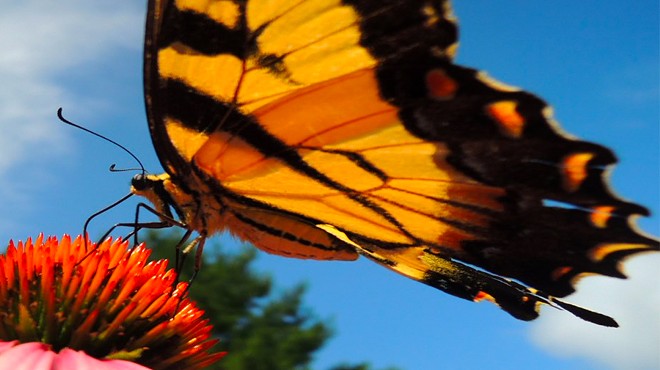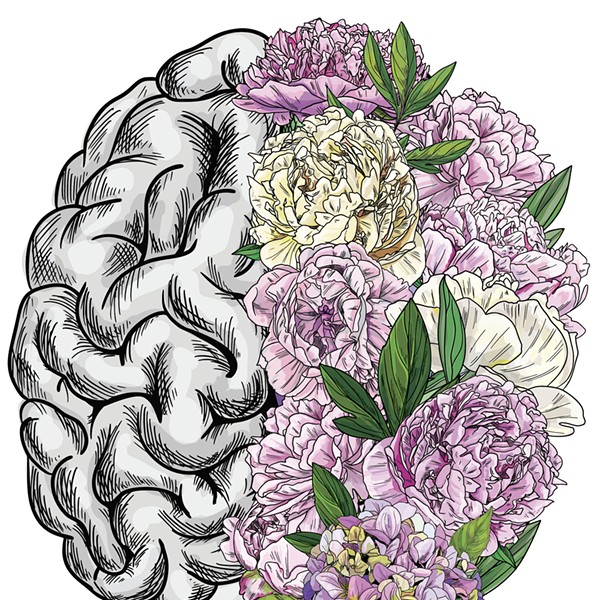Every day during New York City’s long pandemic year, Kathleen Sweeney would counterbalance a sense of fear and isolation by walking a block from her apartment and opening herself up to the beauty of nature in Fort Tryon Park. “I was tracking raptors, hawks, kestrels, and all kinds of birds, and these moments would awaken a sense of awe that was key to my resiliency,” says Sweeney, a multimedia artist and teacher of media studies at the New School. “It was a way of counteracting the dark forces of the news cycle, the daily death counts, and the sound of ambulances. The cultivation of awe was a remedy for me, and it became essential to my sense of wellbeing.”
Bolstering her intuitive feeling that awe could heal, Sweeney followed the work of scientists like Dacher Keltner, psychology professor at the University of California, Berkeley, and founding director of the Greater Good Science Center, who studies the psychophysiology of awe and other positive emotions. Sweeney knew that practicing awe brings tangible health benefits, including toning the vagus nerve—the longest nerve of the autonomic nervous system, which can turn off the fight-or-flight stress reaction and trigger our relaxation response. To intensify the effects, she combined her awe walks with a daily gratitude practice. “I was thankful for the park, the birds, the amazing flowers, and the fact that we lived in a place where people were wearing masks and protecting themselves,” she says. She also started documenting street art as a way to connect with the humanity and creative expression in the urban space. That, too, evoked awe, and she believes these practices helped her stay strong, regulate stress and grief, and maybe even avoid the virus while living in a hot spot.
“This has been a year where slowing down has been foisted upon us, but it’s for our own good to really pay attention to our surroundings,” Sweeney says. “There were people who got deathly ill. And that’s part of the gratitude also—knowing that we’re here on this planet for a short time and this is our opportunity to tap in, open our eyes in a different way, and cultivate that connectivity to the beauty around us.”
Awe As An Intervention
If there is one emotion that’s a panacea for our pandemic times, it’s awe. Scientists often describe awe as the tsunami of feeling we get—the sense of being taken aback—when we’re in the presence of something vast, sublime, or beyond our immediate understanding. We feel it while witnessing a technicolor sunset or a pink moonrise, a forest cloaked with monarch butterflies or a bioluminescent bay. Awe is often catalyzed by nature, but it doesn’t have to be. You can be awed by Cirque du Soleil dancers, a person solving a complicated math equation, or even a good Samaritan giving up their seat for an elderly person on the bus. What you may not know is that awe has a robust and growing science around it, and the findings show that experiencing awe regularly can be a powerful salve to both our mental and physical health.“The study of awe developed as an offshoot of research into positive emotions in general, which took root over the last 15 to 20 years,” says Michele Tugade, professor of psychological science and director of the Affective Science Laboratory at Vassar College. “While a lot of positive emotions [like joy or contentment] are about what is rewarding and feels good to you, what’s different about awe is that it’s no longer about you. It brings your senses and attunement outside of yourself.” Awe’s power to make us feel small in the face of something big may explain why it’s said to offset narcissism and induce “prosocial” behaviors in people, such as generosity and compassion. In one study by Keltner, participants who were told to gaze at a grove of massive eucalyptus trees were more likely to help a passerby who dropped a handful of pens in the dirt moments later. The people in the control group, who were instructed to look at a building façade instead, were less likely to help the poor pen-dropper.
Awe research is filled with dazzling moments like these, including studies of NASA astronauts who’ve been known to experience intense awe while looking at the Earth from outer space, a phenomenon known as the overview effect. But you don’t have to go to the moon to reap awe’s benefits, which can range from a boosted immune response to helping people reframe their troubles and feel more connected and adaptive.
In the research landscape, Tugade has carved out a space for herself by studying the way positive emotions, including awe, can help fuel our resilience in the face of stress, anxiety, and other life challenges. “The theory that I’ve been working on is that positive emotions help you downregulate your negative experiences,” she says. In the lab, she and her students conduct experiments where they induce a negative emotion in participants by showing them a film that brings up fear or anxiety, or by having them engage in a real-life stressor such as giving a public speech. Then they see how awe helps the participants downregulate afterwards, perhaps by showing them a film filled with expansive nature imagery. “What we’ve found is that when you experience positive emotions after a stressful event, your physiological reactivity is regulated,” she says. “It brings you back to your baseline so you can have more effective problem-solving, and it actually broadens the scope of your attention.”
One way awe does this is by deactivating the anterior cingulate cortex, which is the part of the brain that fires up when you’re under alarm. “When you’re feeling awe, you let go of your vigilance,” Tugade explains. That’s a good thing, because being in a constant state of high alert can exert wear and tear on your body. Awe also increases our capacity for accommodation, which is the psychological term for having greater flexibility in our strict cognitive structures. “You’re more likely to have greater agility in who you think you are,” she adds. “With respect to COVID, awe allows us to change our mindset about ourselves so we can adjust, adapt, and have greater strength to cope in times of threat and uncertainty like these.”
Finding Awe in the Everyday
For Chris Duffy, an LA-based comedian, writer, and host of the TED and PRX podcast “How to Be a Better Human,” awe has been a potent antidote to a two-year stretch of stressful life happenings. Family members were dealing with chronic, undefined health problems. The TV show he was writing for ended. And then the pandemic hit. He turned to awe as a way to avoid spiraling into anxiety and overthinking. “During quarantine, there weren’t many ways for me to get out and do something,” he recalls, “though outdoor swimming was still safe. I’d heard that you could take an awe walk, but I wondered, can you do an awe swim?”
Turns out, he could. Sometimes he went to an inspiring place like the beach, yet often he simply swam laps in the public pool. And he was able to find awe in both places. “I would try to deliberately find moments of, ‘It’s amazing that this can exist and I get to be in this moment.’ One way was to look at the way the light came through the water while I was swimming,” he says. “Just being able to see such a simple thing as the way a ray of light refracts through the water, and being present for that, I was able to have this sense of how lucky I was to be there.” Duffy made it a practice to awe-spot regularly, but only for a certain period of time. “It wouldn’t work for me to say, ‘I’m going to walk around all day cultivating awe and just be this raw, open nerve.’ Because then I’d end up getting frustrated. That’s a little too much awe for one person.”
Practicing awe during a daily half-hour swim was enough to reset his mind and refill his cup, and he felt like he had more to give. “This is where it’s a little like crystals and burning sage, but I do think that loving feeling of experiencing awe and being grateful actually transfers to the people around you,” says Duffy. He also noticed benefits in his creative life. “As a comedian, I know it helps to keep that sense of childlike wonder and awe, because that’s what comedy is about. It’s saying, ‘Wait a second—can you believe this?’” And he credits awe with helping him unlock the ability to start new projects. “It’s a really useful way to get unstuck from thoughts like, ‘What if I’m not good enough?’ When I feel awe and this connection to something natural and powerful and beautiful, that makes me think, ‘Well, why not? Let me just try and see what happens.’”
Making Space for Astonishment
The connection between awe and creativity is a powerful one, and it’s something to which Natalie Nixon, a creativity strategist based in Philadelphia, has devoted a lot of thought. “I define creativity as toggling between wonder and rigor to solve problems,” says Nixon, whose book The Creativity Leap: Unleash Curiosity, Improvisation and Intuition at Work (2020) has been named one of Fast Company’s 2021 World Changing Ideas honorees. “Awe, along with curiosity, is a dimension of wonder—it’s visceral and rooted in the moment, and it takes us to another level of human experience.”
Scientists like Tugade and Keltner say we should seek out experiences that give us goosebumps so we can harness awe’s benefits—such as an expanded sense of time and enhanced feelings of wellbeing, selflessness, and humility—and Nixon has ideas on how to do that. “Going through the five senses is one way that we can be more attuned to awe and trigger it in our daily lives,” she says. It can happen at her favorite Indian restaurant, when she takes the first bite of fragrant biryani (“I feel awe for all the dimensions and subtleties of flavor, cinnamon and cloves and cardamon; it’s this overwhelmingly simple yet magnificent experience”). Or listening to Beethoven’s 9th Symphony, “Ode to Joy,” and feeling the swell of voices and strings transport her beyond herself, while also connecting her to all humanity. “Awe often depends on the element of surprise,” she says, “but we can create environments in really simple ways for ourselves to be awe-inspired.”
Some of us are simply more open to awe, and that’s lucky. “People who have either a greater propensity to awe, or those who experience more awe in their everyday lives, are the ones who demonstrate [awe’s benefits the most] on things like immune-system functioning,” says Tugade. But if it doesn’t come naturally, it can be nurtured. “You get better and better at cultivating these positive emotions, to the point where you’re more awake to the possibility of awe and wonder,” says Sweeney. Tugade suggests visiting masterpieces in a museum, paying attention to a great conversation, or doing a small act of kindness for someone, which will inspire a moment of awe in them as well as in you.
As we step into a new phase of the pandemic, awe could be just the thing to help us downregulate from high alert to new normal, whatever that looks like. Expanding our sense of what’s possible, we find there’s more to our world than we thought we knew. Feeling small in the face of something vast, we realize it’s not just about us. That’s humbling yet incredibly freeing, too.














